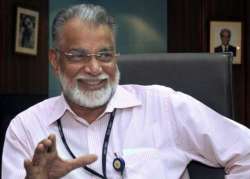2015 to be busy year for Indian space programme: ISRO chief
Chennai: The year 2015 is going to be a busy year for the Indian space agency. It will launch five foreign satellites apart from its own four navigation satellites and a communication satellite.The Indian Space

Chennai: The year 2015 is going to be a busy year for the Indian space agency. It will launch five foreign satellites apart from its own four navigation satellites and a communication satellite.
The Indian Space Research Organisation (ISRO) will also launch -- from Sriharikoka in Andhra Pradesh - a heavy communication satellite, GSAT-15, with around 40 transponders-automatic receivers and transmitters for communication and broadcast of signals using the Ariane rocket of Arianespace.
"We will be completing the IRNSS (Indian Regional Satellite Navigation System) constellation by launching four more satellites and operationalise the navigation system. The geosynchronous satellite launch vehicle (GSLV) rocket is getting ready to launch GSAT-6 communication satellite," ISRO chairman K. Radhakrishnan said.
He said astronomy satellite Astrosat will be launched in 2015.
As to the commercial launches, India will launch five foreign satellites next year including three from Britain. India has also signed up contracts to launch two Indonesian satellites.
Radhakrishnan said 2015 will see ISRO enhancing the space applications for the central and state governments.
Queried whether ISRO was dispersing its resources looking at human space mission when the focus should be on developing GSLV rockets to carry heavy communication satellites, Radhakrishnan said: "ISRO's projects are not mutually exclusive. The cryogenic engine for the heavy rocket is under development and will take two years for the rocket to be flight ready."
The Indian space agency will test fly its heaviest rocket GSLV-Mark III designed to carry satellites weighing around four tonnes.
While the rocket's cryogenic engine is under development, ISRO decided to test the atmospheric flight stability of the rocket, with the two engines carrying a giant cup cake alike crew module.
The crew module will not carry any living being and is only for learning the atmospheric re-entry characteristics of the module.
The main objective of the crew module is to demonstrate its re-entry flight and aero braking; end-to-end parachute system validation.
The 630-tonne rocket will go up to 126 km. The crew capsule got detached and fell into the Bay of Bengal 20 minutes after blast off.
The descent speed of the crew module will be controlled by three parachutes.
According to an ISRO official, it will be in the size of a small bedroom and can accommodate two-three people.
On infrastructure development, Radhakrishnan said the second rocket assembly building at Sriharikota in Andhra Pradesh will increase the number of launches from the second launch pad.
"Study is under progress on the construction of a third launch pad. We have to take into consideration the kind of launch vehicles - GSLV-Mark III - and other future rockets to be developed while building the third launch pad," Radhakrishnan said.